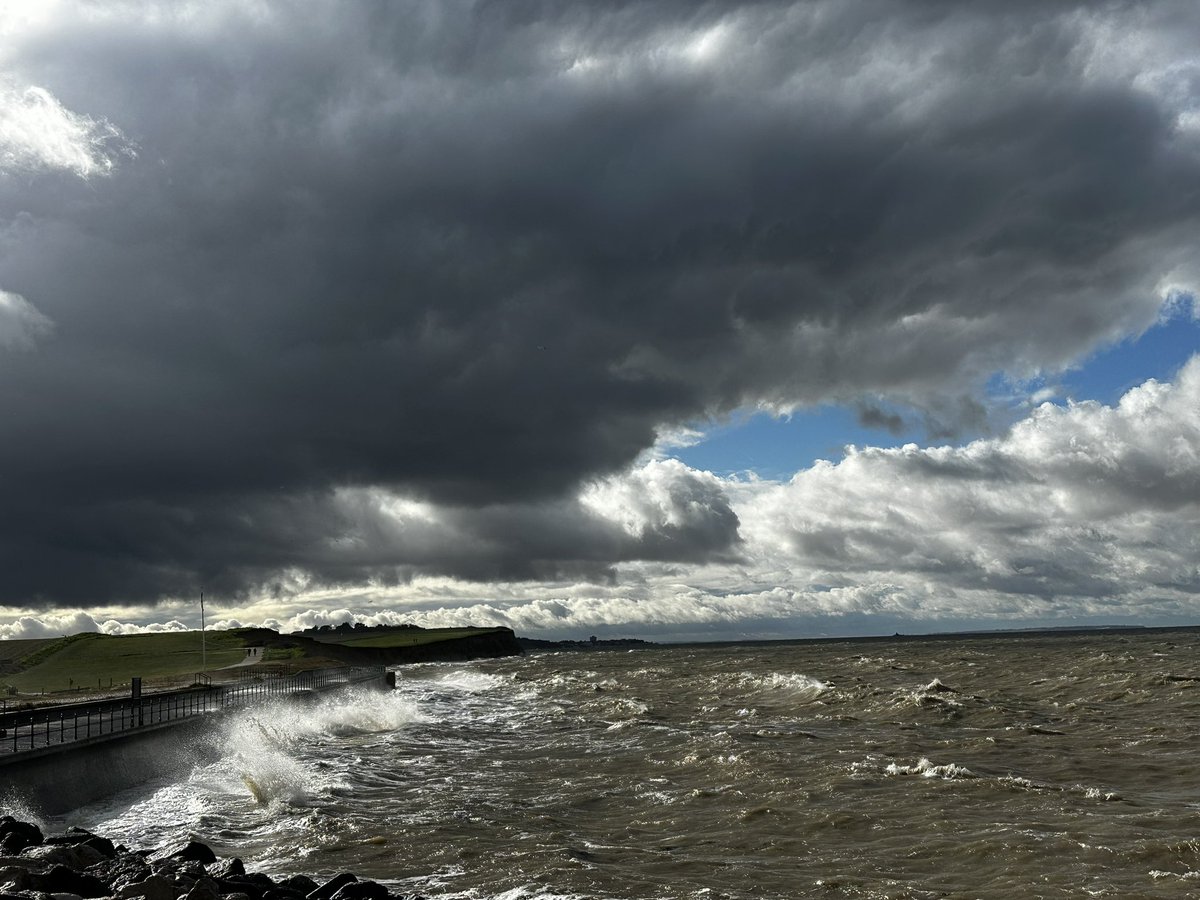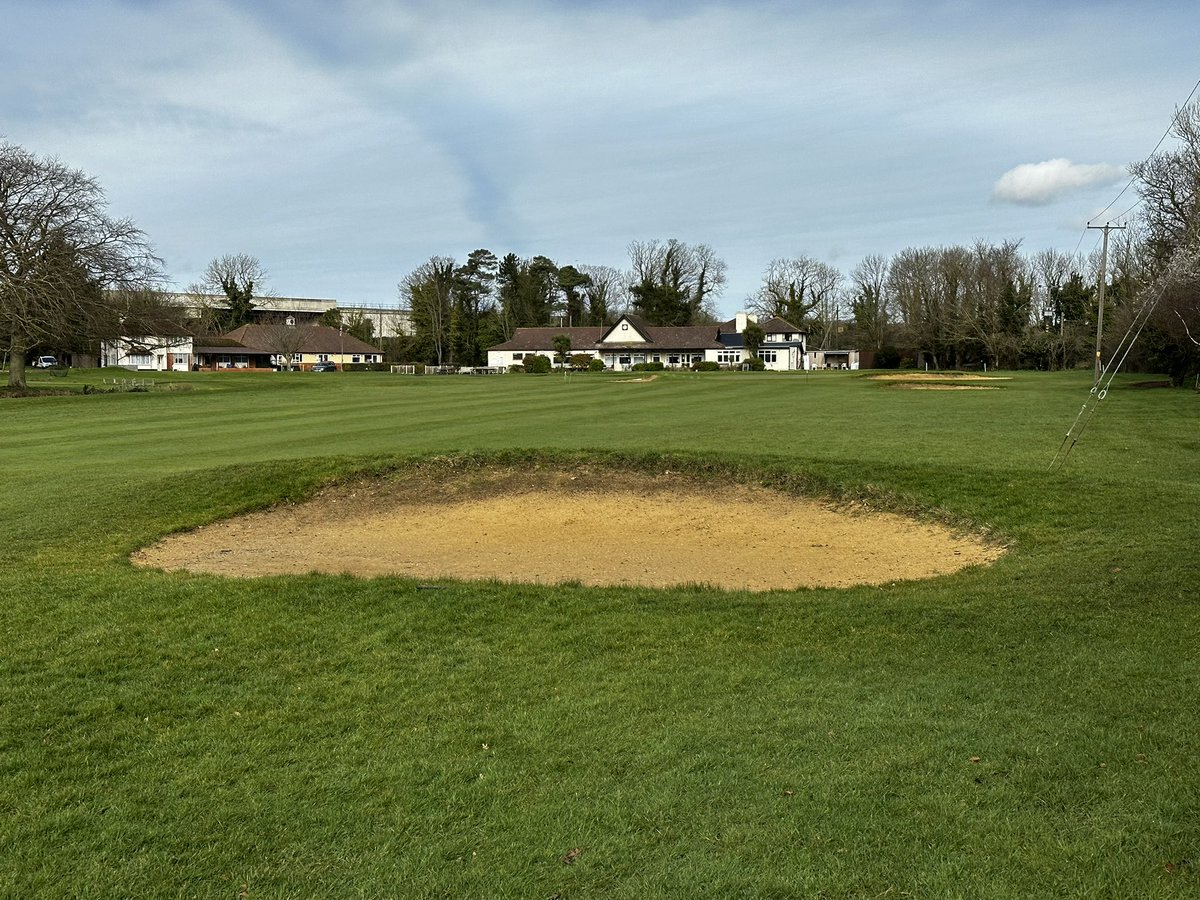
Up bright and early, to set off with @jamiembrixton on a tour of pre-Norman Conquest Kent! #PreConquestKent 

Huge excitement as we arrive at the first stop on our tour of #PreConquestKent: a Romano-British temple found during the building of a housing estate in Newington, just off Watling Street.
@jamiembrixton engages in some top archaeological research, scoping out the very site.
@jamiembrixton engages in some top archaeological research, scoping out the very site.

The remains of the temple were moved 70 metres to a neighbouring recreation area. It dates to the 1st century, & stood in what seems basically to have been a huge industrial zone, producing iron & pottery. Although massively developed under the Romans, it was originally Iron Age. 



Newington is one of the many places in Kent that have been identified with the enigmatic Roman station Durolevum: a long-lost site that is to historians of ancient Kent what El Dorado was to the Conquistadors… #PreConquestKent
Minster Abbey, built on the highest spot on the Isle of Sheppey. The original foundation was a donation made in 670 by King Ecgberht of Kent to his mother, the splendidly named Sexburga. Destroyed by the Vikings in 855, it was refounded soon after as a Benedictine nunnery. 





The A-Saxon convent church still survives, directly adjacent to a second, parish, church, built in the 12th century. Its windows feature Roman bricks; one of its doors a green man. The chapel was re-dedicated in 1927 to St Sexburga, and is a place where the past seems very close. 







The tomb of Sir Robert de Shurland features the head of a horse rising from the waves. The story goes that Sir Robert, having killed a priest, swam out on his horse 2 miles to obtain a pardon from Edward I, who was on a ship off the Isle of Sheppey. Then they both swam back…
…where another priest accused the horse of having necromantic powers. Sir Robert - who was clearly a most ungrateful piece of work - promptly chopped off his horse’s head. A year later, out on his new horse, he was thrown, fell onto the skull of his old horse, & DIED FORTHWITH.
Another tomb in Minster Abbey, of an unknown knight, shows him holding an egg containing a tiny baby: perhaps a representation of his soul ascending to heaven 



An enigmatic Roman monument set in a field outside Faversham - probably a mausoleum, but perhaps a shrine or even a chapel. If a mausoleum, it is the only known example in Britain of one subsequently converted into an A-Saxon church. There are also Norman & medieval additions. 







“It is thought,” reports English Heritage, “that the Roman settlement of Durolevum was situated on the outskirts of Faversham, & that this mausoleum is all that survives above ground of that settlement” - but obviously the good folk of Newington would disagree…
(I realise that I neglected to include my photos of Sir Robert de Shurland & his magical horse a few tweets back - so making amends here.) 



Windows at St Mary’s Reculver commemorate the coming to Kent of Augustine, & the welcome given him by Æthelberht & his Frankish queen Bertha.
The first two windows are Victorian; the window portraying Bertha was added in the 70s. #PreConquestKent


The first two windows are Victorian; the window portraying Bertha was added in the 70s. #PreConquestKent



The fort of Regulbium was built in the late 2nd century, to send sentry over both the Thames Estuary to the north, & the Wantsum Channel, which separated the mainland from the Isle of Thanet. It is perhaps the most romantically situated of all the Saxon Shore forts. 


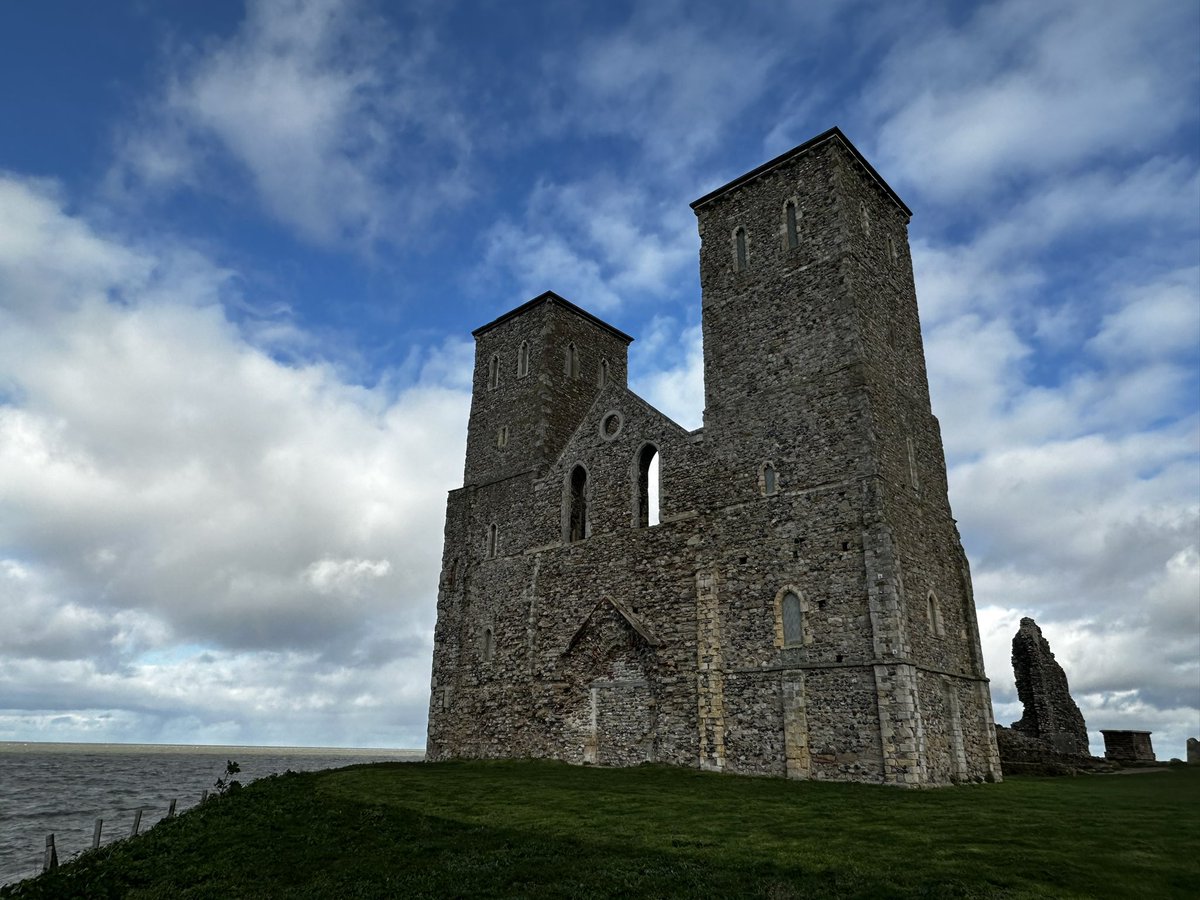
In 670, records the A-Saxon Chronicle, King Egbert gave the abandoned Roman fort ‘to Bass the mass priest in which to build a minster’. By 1066 the monastery had become a parish church, & so it remained until 1809, when erosion required its removal inland, leaving just a shell. 

View from the east gate of the Roman fort across what was once the Wantsum Channel, and now is just flat, dry land. The Isle of Thanet is no longer an isle. 

Not all the Roman fort has vanished into the sea. There is a good stretch still guarding its southern flank, and another portion in the car park of the local pub. #PreConquestKent 




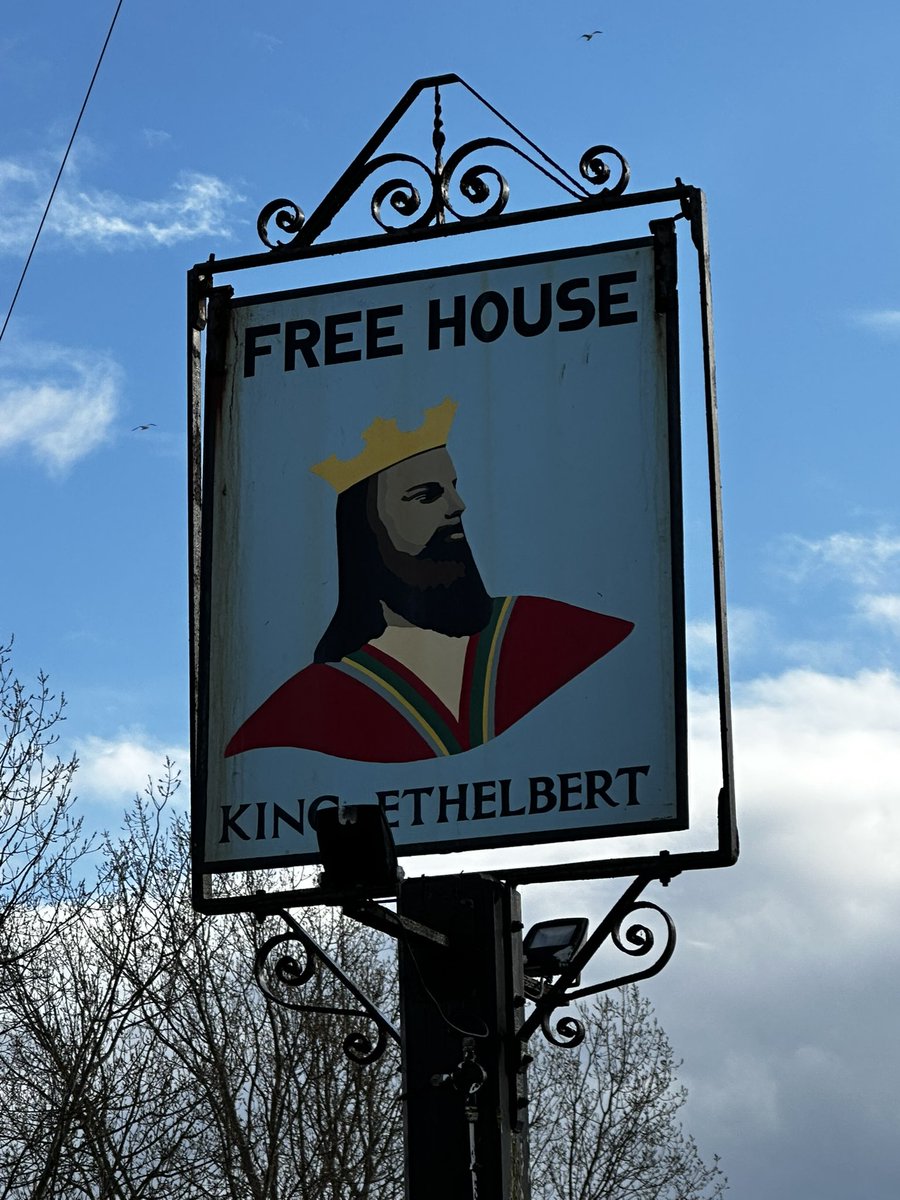
The beach at Walmer. A memorial on the seafront proudly boasts: “THE FIRST ROMAN INVASION OF BRITAIN LED BY JULIUS CAESAR LANDED NEAR HERE LV BC.” As @llewelyn_morgan convincingly argues, Caesar probably landed here in LIV as well. llewelynmorgan.com/2020/08/12/dea… 



To Eopwinesfleot - Ebbsfleet- where, according to the Anglo-Saxon Chronicle, Hengist & Horsa landed in 449 at the invitation of Vortigern, and Augustine, according to tradition, landed to evangelise the barbarous pagans of Britain #PreConquestKent 



The Hugin sailed in 1949 from Denmark to commemorate the 1500th anniversary of the supposed landing of Hengist & Horsa. It was visited by @jamiembrixton in 1956 & featured in Doctor Who in 1965. britishpathe.com/asset/ 



St Augustine’s Cross, erected in 1884 to commemorate the landing of St Augustine in 597, and featuring a Latin inscription composed by Henry Liddell, the father of Alice in Wonderland 



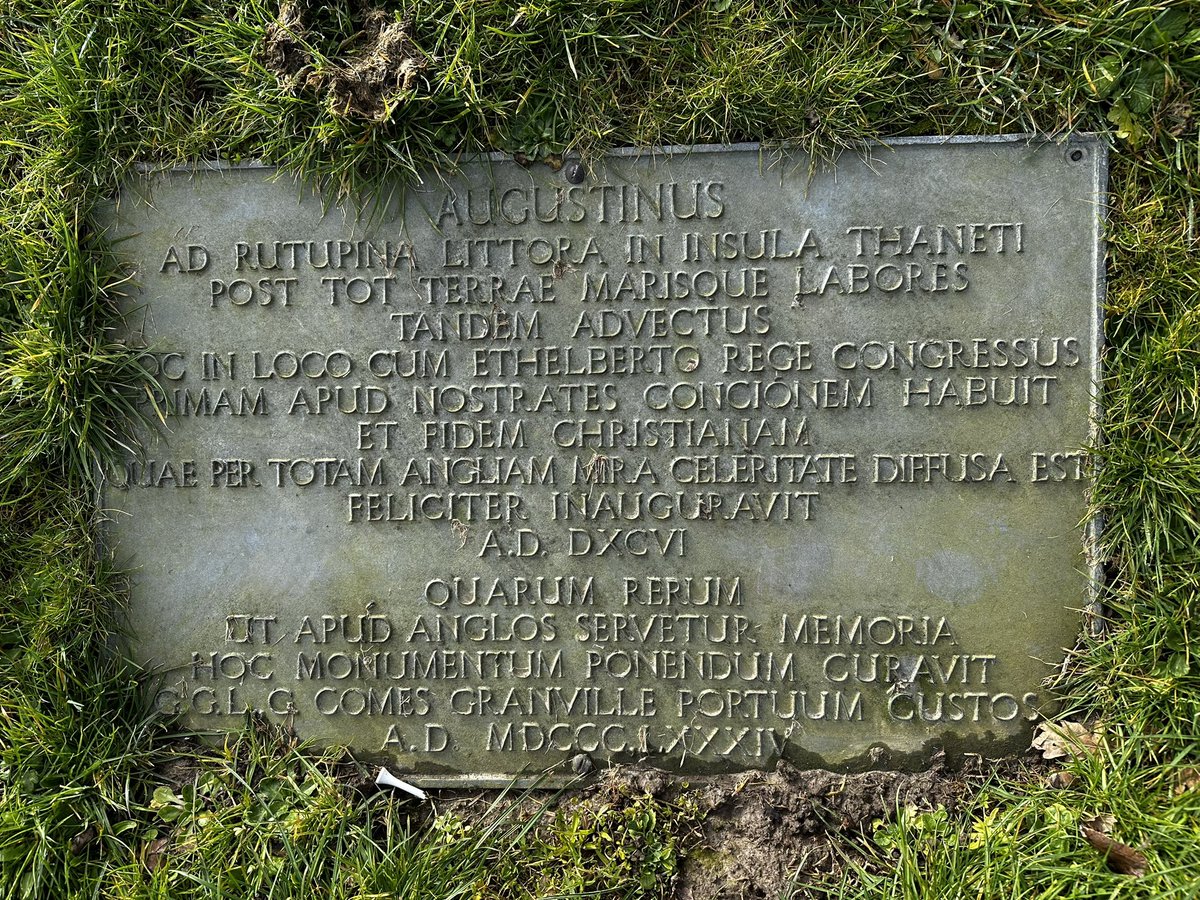

The pool on St Augustine’s Golf Course - much frequented by Norman Wisdom & Bruce Forsyth - where, according to tradition, St Augustine performed the very first baptism on English soil.
A truly English sacral site…
A truly English sacral site…

Roman bowl, early 3rd century, found outside Sandwich #PreConquestKent 

Roman head found by two boys playing near the fort at Richborough. They took it home and gave it to their grandmother, who kept it in her garden for years, until finally it was given to Sandwich Museum 

Excellent map in @sandwichmuseum of the Wantsum Channel, which once separated the Isle of Thanet from the mainland. It shows just how strategic the positioning of the two forts of Reculver (3) and Richborough (8) were in enabling the Roman high command to control the channel. 

The amphitheatre at Richborough - as it was in Roman times; during the excavation conducted here in 2021, which showed that it was being used right up to the end of the Roman period; and the - frankly less than exciting - view of it today 





The hulking fortifications of Richborough. As @pompei79 would put it, the very essence of #WallPorn. Appropriately, the factory beyond the trees in the second photo is where Viagra was developed. 



Sadly, the fort is still shut for the winter, so no chance to see the cruciform foundations of the great quadrifons arch that once welcomed Roman travellers to Britannia, nor the 4th century baptismal font, nor the chapel founded c. 700 & dedicated to St Augustine ☹️ 

The great hill that looms over the port of Dover - one of the bases of the Classis Britannica, the British Fleet - was occupied 1st by an Iron Age fort & then by 1 of 2 Roman lighthouses that served to guide shipping from Boulogne. A church - St Mary-in-Castro - was built c. 1000 

The Roman lighthouse - which dates back all the way to the time of Claudius, who ordered the invasion of Britain- was converted into the bell tower of the church. The top stonework is 15th century, but the lower reaches rank as the oldest surviving lighthouse in the country. 

The church of St Mary & St Æthelburh in Lyminge is 1000 years old, but the site also once boasted one of the earliest churches built in England, c. 633. Æthelburh was the daughter of Æthelberht of Kent & the widow of Edwin of Northumbria - so a hugely significant figure. 

The church Æthelburh founded was excavated in 2019, right next to the existing church. A surviving window with Roman bricks may once have opened on to the site of Æthelburh’s tomb, allowing the faithful to glimpse inside. Æthelburh’s remains were removed in 1085 to Canterbury. 







Gone but not forgotten… #SaintÆthelburh 



To Durovernum Cantiacorum! (And specifically @CburyCathedral…) 

The Reculver Cross, brought from Reculver to @CburyCathedral when the church at Reculver was demolished in 1809. “It’s position inside the church suggests that it was erected before 669, & that its construction out of drums accords with late antique practice” - Ruth Kozody 



“The Reculver Cross has long seemed to hold out a tantalising promise - that it might dispel some of the mystery still surrounding the gap between the waning of late classical art in Britain & the vigorous burgeoning of Anglo-Saxon sculpture” - Ruth Kozody
The base of the Reculver Cross. “The central figure holds a scroll slightly unrolled: it must represent Christ, who is often depicted with a scroll to emphasise his role as a teacher.” 

Stone II of the Reculver Cross shows the Ascension. “Christ’s bare feet rest on two separate smoothly rounded hills. His left foot is firmly planted on the ground.” 

“I suggest the Reculver Cross stands as a link between Mediterranean & A-Saxon art. The Cross shows that the transition from Hellenistic to English art was made in Kent, in the 7th C, quite possibly the early 7th C.”
(Other scholars date it to the 9th C, but I want to believe.)
(Other scholars date it to the 9th C, but I want to believe.)
Some breakfast reading… #PreConquestKent 



To a church service in what may originally - very possibly - have been a Roman mausoleum… #PreConquestKent
St Martin’s, Canterbury - the oldest church in continuous use in England.
It seems originally to have been a mausoleum, converted into a church by Liudhard, who was serving as chaplain & bishop to Bertha, the Frankish queen of Æthelberht, King of Kent.
It seems originally to have been a mausoleum, converted into a church by Liudhard, who was serving as chaplain & bishop to Bertha, the Frankish queen of Æthelberht, King of Kent.

“The most plausible interpretation of the first phase of St Martin’s is that it was a Late Roman mausoleum, employed in the late 6th century as a church for Bertha and the few other Christians in the court before the Mission” - Ken Dark
St Bertha, set against Roman brickwork
St Bertha, set against Roman brickwork

This - bringing as it does the age of Augustine’s mission to Kent into communion with the ghosts of Roman Canterbury - is one of the most quietly haunting spaces in Christian Europe
View from St Martin’s of @CburyCathedral.
Æthelberht’s HQ stood outside the abandoned city, & Augustine - though he would doubtless have preferred to base himself within an urban fabric so expressive of Romanitas - opted instead to base his mission close to the king & his queen.
Æthelberht’s HQ stood outside the abandoned city, & Augustine - though he would doubtless have preferred to base himself within an urban fabric so expressive of Romanitas - opted instead to base his mission close to the king & his queen.

“On the east side of the city there stood an old church built in honour of St Martin during the Roman occupation of Britain, where Queen Bertha, who was Christian, came to pray” - Bede
The origins of the building (even if not its status as a church) really do seem Roman…
The origins of the building (even if not its status as a church) really do seem Roman…

St Pancras: “the earliest ‘Anglo-Saxon’ church yet known, the earliest part of St Augustine’s Abbey and the only visible building both consecrated and used by Augustine himself.” (Ken Dark) 

All that remains of the Church of SS Peter and Paul, founded by Augustine c. 609, but consecrated by Augustine’s immediate successor, Laurence. The tombs of both archbishops, together with that of Theodore of Tarsus, Archbishop from 668 to 690, stood here. Requiescant in pace. 







“It was probably not for another 40 or more years (long after King Aethelberht and St Augustine had died) that the main base of the Archbishop of Canterbury was finally moved to a newly built mega-church in the heart of the ruined Roman city: the first Canterbury Cathedral.’” 

There really should be more statues of Bretwaldas #PreConquestKent 

And Frankish princesses #PreConquestKent 

Pieces of wall and floor from a Roman house exposed by the German Baedeker raid on Canterbury in 1942 

Anyway, the Roman Museum in Canterbury is great
https://twitter.com/jamiembrixton/status/1634890550758326272
And so our tour of #PreConquestKent comes to an end in the crypt of Canterbury Cathedral, with @jamiembrixton admiring two Roman pillars brought there from Reculver 

• • •
Missing some Tweet in this thread? You can try to
force a refresh




